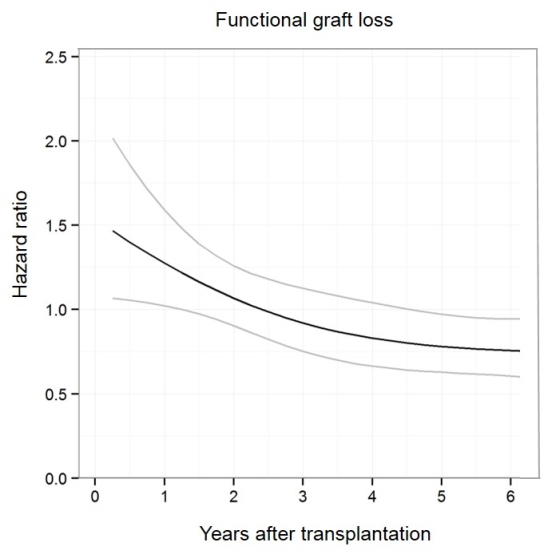The Optimal Time Point for Steroid Withdrawal After Kidney Transplantation Is One Year After Engraftment.
1Center for Medical Statistics, Informatics and Intelligent Systems (CeMSIIS), Medical University of Vienna, Vienna, Austria
2Department of Medicine, Medical University of Vienna, Vienna, Austria.
Meeting: 2016 American Transplant Congress
Abstract number: 284
Keywords: Immunosuppression, Kidney transplantation
Session Information
Session Name: Concurrent Session: Belatacept and Steroid Withdrawal in Kidney Transplantation
Session Type: Concurrent Session
Date: Monday, June 13, 2016
Session Time: 4:30pm-6:00pm
 Presentation Time: 4:42pm-4:54pm
Presentation Time: 4:42pm-4:54pm
Location: Ballroom A
The optimal time of steroid withdrawal after kidney transplantation remains elusive, since RCTs can evaluate one predefined time point. Thus we analyzed all first kidney transplant recipients in the Austrian Transplant Registry from 1990 to 2012 using landmarking in Cox models. Hazard ratios and 95% CI for mortality and graft loss were calculated at each landmark time to compare steroid withdrawal and steroid maintenance. To reduce bias from confounding by indication we introduced propensity score (PS) matching with a caliper of 0.1 PS logit standard deviations between exposure groups at each landmark time.
A total of 5170 first kidney transplant recipients were included in the analysis with a mean follow-up 6.5 years. Overall 2128 patients were withdrawn from steroids within the observation period. We found the optimal time point for steroid withdrawal was one year after engraftment, because steroid withdrawal was associated with a higher rate of graft loss six months after transplantation (HR 1.4; 95%CI 1.1-1.9) compared to steroid maintenance, but thereafter the rate of graft loss was no longer statistically different (figure 1). All-cause mortality was not different between groups throughout follow-up.
Our data suggest that steroids should not be withdrawn within the first year after transplantation. Our analysis did not reveal any survival benefits in patients who were withdrawn from steroids at any time after transplantation. Despite using contemporary advances statistical methods, all limitations of an observational study apply.
The plot shows estimated hazard ratios with confidence intervals for functional graft loss comparing patients who were withdrawn from steroids at various time points after kidney transplantation compared to those who were maintained on steroids at that time. The hazard ratio for graft loss is higher in those withdrawn from steroids until 2.5 years after transplantation, but the association of steroid withdrawal and graft loss loses significance one year after transplantation.

CITATION INFORMATION: Haller M, Kammer M, Kainz A, Heinze G, Oberbauer R. The Optimal Time Point for Steroid Withdrawal After Kidney Transplantation Is One Year After Engraftment. Am J Transplant. 2016;16 (suppl 3).
To cite this abstract in AMA style:
Haller M, Kammer M, Kainz A, Heinze G, Oberbauer R. The Optimal Time Point for Steroid Withdrawal After Kidney Transplantation Is One Year After Engraftment. [abstract]. Am J Transplant. 2016; 16 (suppl 3). https://atcmeetingabstracts.com/abstract/the-optimal-time-point-for-steroid-withdrawal-after-kidney-transplantation-is-one-year-after-engraftment/. Accessed December 16, 2025.« Back to 2016 American Transplant Congress
